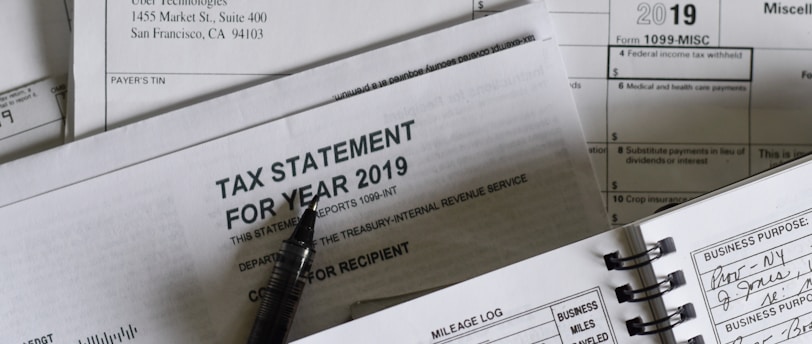How to File Taxes as a Travel Agent | 2025 Step-by-Step Guide
A practical 2025 guide explaining how travel agents file U.S. taxes, including Schedule C, estimated payments, deductions, and what to report.
TRAVEL AGENTS FINANCE
10/28/20255 min read


How to File U.S. Taxes as a Travel Agent: Step-by-Step 2025 Guide
Introduction:
Filing taxes as a travel agent can be confusing, especially when your income comes from commissions, service fees, or supplier bonuses. Many independent agents also work across multiple states or earn in different currencies, which adds another layer of complexity. At Antravia, we help travel professionals understand how to report correctly, maximize deductions, and stay compliant with IRS requirements. Here’s a clear, step-by-step guide for 2025.
Step 1: Determine your Business Type and understanding your Tax Obligations as a Travel Agent
Before you start, identify whether you’re a sole proprietor, LLC, or S Corporation. For example
Sole proprietors and single-member LLCs file using Schedule C attached to Form 1040.
S Corporations file Form 1120-S, and owners receive a K-1.
If you’re still operating under your personal name, you’ll report as a sole proprietor, but the filing process is almost identical.
Travel agents typically file as sole proprietors if independent, reporting business profits and losses on their personal tax return (Form 1040). You'll pay income tax on net profits plus self-employment tax (15.3% for Social Security and Medicare in 2025, with the Social Security portion capped at $176,100 of net earnings). If your net self-employment earnings are $400 or more, you must file and pay these taxes. No major changes to self-employment tax rates occurred for 2025—the rate remains steady at 15.3%, but the Social Security wage base increased from $168,600 in 2024 to $176,100. An additional 0.9% Medicare tax applies if your total income exceeds $200,000 (single) or $250,000 (married filing jointly).
Key forms include:
Form 1040: Your main individual tax return.
Schedule C (Form 1040): Reports business profit or loss.
Schedule SE (Form 1040): Calculates self-employment tax.
Form 1040-ES: For estimated tax payments.
If you're part of a partnership or LLC, different forms may apply so check your business structure.
Step 2: Gather your Income Records
You’ll need every source of income earned during the year such as commissions, service fees, booking charges, overrides, bonuses, and even affiliate or advertising revenue. Host agencies often issue Form 1099-NEC if they paid you over $600. If you also received supplier incentives, marketing funds, or referral payments, those count as taxable income. Keep records from each host or vendor portal (e.g., Travel Leaders, Nexion, or Virtuoso).
Report Your Income
Calculate gross income: Include all commissions, fees, and bonuses from bookings, overrides from suppliers, and any incentives. Report on Schedule C, Part I.
Subtract cost of goods sold (if applicable): For travel agents, this might include direct costs like tour packages resold.
Handle sales tax: If you collect sales tax on services (varies by state), report it separately—it's not part of your income.
Net profit/loss: This flows to Form 1040 and is used for self-employment tax
Step 3: Collect and Categorize Expenses and consider deductions
Travel agents can deduct legitimate business expenses such as booking software subscriptions, CRM systems, merchant fees, advertising, professional dues (ASTA, CLIA, IATA), continuing education, and travel expenses related to business. Use accounting software like QuickBooks or Xero to categorize them under standard IRS codes. This helps you fill Schedule C accurately and reduces audit risk.
Deductions lower your net profit, reducing both income and self-employment taxes. Common ones for travel agents:
Home office: Deduct a portion of rent/mortgage, utilities, and insurance based on square footage used exclusively for business (e.g., a dedicated workspace).
Travel expenses: Deduct "fam" trips (familiarization) for researching destinations, if primarily business-related. Include airfare, lodging, meals (50% deductible), and transportation. Personal portions aren't deductible—document business purpose daily. Cruises have a $2,000 annual cap for conventions/seminars.
Vehicle/mileage: Standard mileage rate or actual expenses (gas, repairs) prorated for business use. Track local drives to client meetings or events.
Marketing and education: Ads, website costs, trade publications, conferences, and professional dues (e.g., CLIA membership).
Office supplies and tech: Phones, internet, software, fax, and copiers (prorated if mixed use).
Client incentives: Discounts you fund (not underwritten by vendors).
Other: Business credit card interest, second phone lines, and group trip costs if hosting clients.
Report on Schedule C, Part II. Keep receipts for at least three years for audits. You can also deduct half your self-employment tax on Form 1040.
Step 4: Calculate Self-Employment Tax
Travel agents are considered self-employed, meaning they must pay both income tax and self-employment tax, which covers Social Security and Medicare. The current self-employment rate is 15.3% on net profit (12.4% Social Security and 2.9% Medicare). If your net earnings exceed $400, you must file.
Step 5: File Estimated Taxes Quarterly
Because taxes aren’t automatically withheld from commissions or fees, you must make quarterly estimated payments to the IRS. Self-employed individuals must pay taxes quarterly if expecting to owe $1,000+ annually. This covers income and self-employment taxes
The deadlines for 2025 are April 15, June 16, September 15, and January 15, 2026. You can pay electronically using the IRS Direct Pay system or EFTPS. Keeping up with quarterly payments prevents penalties and interest. Here is more info:
Calculate using Form 1040-ES: Estimate based on prior year or current projections.
Due dates for 2025 (for 2024 tax year income):
April 15, 2025 (Q1: Jan-Mar)
June 17, 2025 (Q2: Apr-May)
September 16, 2025 (Q3: Jun-Aug)
January 15, 2026 (Q4: Sep-Dec)
Pay via IRS.gov/payments, EFTPS, or mail. Adjust if income fluctuates to avoid penalties (aim for 90% of current tax or 100% of prior year's)
Step 6: Prepare Schedule C
Schedule C is where you report your total income and deductible expenses. The net profit flows into your Form 1040. Line categories include:
Advertising
Commissions and fees
Contract labor (IC assistants)
Travel and meals
Office expenses
Utilities and rent
Always match your expense categories to accounting records to simplify your year-end reconciliation.
Step 7: Report Additional Income Sources
If you earned affiliate commissions, referral income, or blogging revenue, list them separately in Part I of Schedule C as “Other Income.” If you receive payments through PayPal, Stripe, or a booking system, review your Form 1099-K to ensure all income is captured as the IRS now matches these electronically.
Step 8: File Electronically and keep Records
Use tax software like TurboTax, TaxAct, or a CPA familiar with travel industry accounting. File electronically for faster confirmation. Keep records for at least three years, including receipts, supplier invoices, and payment statements.
Step 9: Consider State-Level and BOI Filings
Some states require separate filings if you operate under an LLC or S Corporation, including franchise tax or annual reports. You should also verify your Beneficial Ownership Information (BOI) filing under the new FinCEN rules effective January 2025 if your travel business is registered as an LLC or Corporation. Note that there are new BOI exemptions, so you may qualify.
Conclusion:
Filing U.S. taxes as a travel agent is understanding how your business structure and income sources work together. But if you’d like tailored help organizing your books before tax season, Antravia offers accounting and compliance guidance specifically for travel agents.
Also review our dedicated tax.travel website for tax advice.


References
IRS – Self-Employed Individuals Tax Center: https://www.irs.gov/businesses/small-businesses-self-employed/self-employed-individuals-tax-center
IRS – Schedule C Instructions: https://www.irs.gov/forms-pubs/about-schedule-c-form-1040
IRS – Estimated Tax Payments: https://www.irs.gov/businesses/small-businesses-self-employed/estimated-taxes
FinCEN – BOI Reporting: https://www.fincen.gov/boi
Disclaimer:
Content published by Antravia is provided for informational purposes only and reflects research, industry analysis, and our professional perspective. It does not constitute legal, tax, or accounting advice. Regulations vary by jurisdiction, and individual circumstances differ. Readers should seek advice from a qualified professional before making decisions that could affect their business.
See also our Disclaimer page
Antravia Advisory
Where Travel Meets Smart Finance
Email:
Contact us:
Antravia LLC
© 2025. All rights reserved. | Disclaimer | Privacy Policy | Terms of Use | Accessibility Statement
Antravia.com - Global site of the Antravia Group.
Antravia.com | Antravia.co.uk | Antravia.ae | Tax.travel | Finance.travel
contact@antravia.com
Antravia LLC
4539 N 22nd St., Ste. N
Phoenix
Arizona
85016
